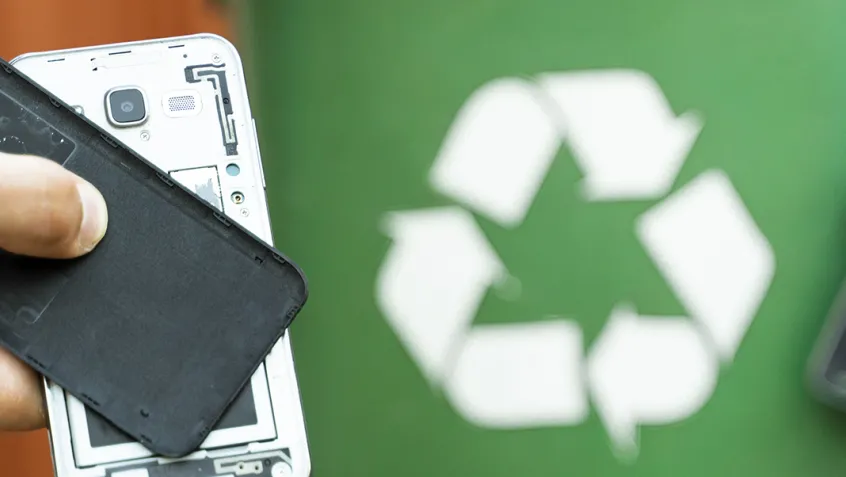
What is E-Waste?
Chances are, you can’t imagine life without your smart phone. But no matter how attached you might be to your phone now, eventually, you will need an upgrade. What happens to your old phone then? It could become “e-waste”—one of the fastest-growing categories of waste worldwide.
In 2014, Americans threw away 416,000 cell phones every day. That’s 151.8 million phones trashed in a single year. Computers, televisions, DVD players, stereos, and copiers are other common e-waste products in our increasingly technology-filled society. As the lifespan of consumer electronics grows shorter and shorter, more and more e-waste finds its way to landfills.
Hidden Consequences
Electronics are made of many materials, including gold, silver, lithium, and other valuable elements. These materials can also be toxic. When e-waste is burned at a landfill, it releases elements like copper, aluminum, and iron into the air that contribute to climate change. Other chemicals like polybrominated diphenyl ethers (PBDE) and polybrominated biphenyls (PBBs) found in electronics can also have a negative effect on human health and the environment.
According to the UN’s Global E-waste Monitor 2020, a record 53.6 million metric tonnes of e-waste was generated worldwide in 2019. That’s an increase of 21% in just five years. National Geographic reported that the average American family throws away 400 iPhones worth of e-waste a year. So where do all those unwanted electronics go?
E-waste frequently ends up in developing countries, where people recover valuable materials by burning discarded devices to melt away the non-valuable parts of the electronics, an unregulated practice referred to as “informal recycling.” This is dangerous because workers do not wear protective equipment while handling dangerous materials and toxins are released that contaminate the air, soil, and groundwater.
Additionally, criminals can take advantage of this process to search e-waste for credit card numbers and other sensitive information from a computer or cell phone’s former owner, since informal recycling does not typically involve devices that have been wiped clean of data.
Recycling is a Golden Opportunity
However, when disposed of properly, e-waste can be seen as an opportunity. Many materials used in electronics can be recovered and reused, including plastics, glass, and metals.
Recovering gold, copper, and other precious metals from e-waste is actually cheaper than mining. But in 2019, only 17.4% of e-waste around the world was recycled properly. Astonishingly, the iron, copper, gold, and other high-value materials from these products that ended up in a landfill or burned has been conservatively valued at $57 billion.
A Future in the Circular Economy
Some progress is being made. The American electronics recycling industry estimates that 5 million tons of e-waste is now recycled each year in the US. Recycling conserves natural resources, reduces greenhouse gas emissions from manufacturing new electronics, and is good for the economy.
Government agencies like the US Environmental Protection Agency (EPA) and multi-stakeholder efforts such as the Solving the E-waste Problem (StEP) Initiative are pursuing long-term, integrated solutions to global e-waste challenges. The responsible management of electronics supports the UN’s sustainable development goals. In the long-run, applying circular economy principles to electronics manufacturing could result in products that are more durable, repairable, and recyclable.
Here’s How You Can Help Cut Down on E-Waste
As technology continues to improve rapidly and becomes less expensive, people want to upgrade their devices more frequently, which leads to more waste. According to a 2013 report by the Consumer Electronics Association, the average American household uses about 28 electronic products, from personal computers to e-readers. All those upgrades eventually add up in the landfill.
Just as technology has changed the speed and way we communicate, we must recognize the substantial impact it has had on the environment. Each of us can be a part of the solution— here’s how.
- Learn about sustainable electronics management. This guide from the EPA is a good place to start.
- Reduce your waste. Hold off on buying a new device until you really need it. Be thoughtful about what you buy. Consider purchasing refurbished products or devices made with recycled materials.
- Repair your current products. If possible, repair your old product rather than purchasing new. Consider upgrading the software or hardware of your computer rather than purchasing a brand new product.
- Recycle electronics appropriately so they don’t enter the waste stream. Many manufacturers and electronics stores recycle electronics for their customers. Be sure to delete all personal information from electronics first. Remove batteries and recycle them separately, if needed
- Donate used electronics. Do you know someone who would benefit from your used phone, laptop, or tv? If not, there’s probably a charity that could use it.


